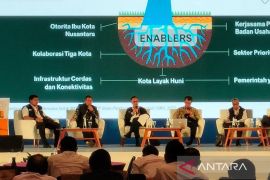The construction is targeted to finish by the end of 2022Jakarta (ANTARA) - The construction of the Semarang-Demak, Section 2, of the Sayung-Demak Toll Road has reached 80.63-percent completion, the Toll Road Regulatory Agency (BPJT) of the Public Works and Public Housing Ministry (PUPR) has said.
"The construction is targeted to finish by the end of 2022," BPJT said in an official statement here on Monday.
The Semarang-Demak Toll Road is expected to augment the connectivity of the toll road network and main arteries on the north side of Java. Coupled with the Semarang City Sea Wall facility, it will further support the new economic center in Central Java.
The toll road will also function as a tidal flood barrier and prevent flooding, which has been a problem in Semarang city.
The 27-km-long toll road has two sections: the 10.69-km Semarang/Kaligawe-Sayung section, which is being built by the government and is expected to be completed by 2024, and the 16.31-km Section 2 of the Sayung-Demak segment, which is being built by toll road business entity (BUJT) Semarang Demak Housing Development (PP).
Related news: PUPR Ministry revitalizes three TPA in East Java
The Semarang-Demak Toll Road will have two interchanges (SS), namely Sayung and Demak. The construction of the road will involve the use of domestic products such as PT WIKA's precast concrete.
The Semarang-Demak Toll Road will be integrated with a sea embankment and reinforced with 17 layers of bamboo mats.
In addition to the bamboo mat system, the soil will be strengthened by installing prefabricated vertical diverting material, or PVD, and carrying out loading using sea sand material taken using a trailing suction hopping dredger (TSHD).
In an effort to minimize the negative impact on the environment from the construction of the toll road, the PUPR Ministry is collaborating with the local government to prepare a mangrove land relocation program around the Semarang-Sayung section. There will be three mangrove relocation sites, covering a total area of 46 hectares.
Related news: Cash Labor-Intensive Program targets fund disbursal in remote areas
Efforts to preserve the mangrove area aim to maintain its function as a habitat for flora and fauna on the north coast of Java and protect the coastline, including reducing the risk of abrasion.
The mangroves' robust root system will also help form a natural barrier against storm surges and floods. River and land sediments are trapped by mangrove roots, thereby protecting coastal areas and slowing erosion.
Related news: PUPR Ministry readies sarhunta at Borobudur Temple ahead of Vesak Day
Related news: PUPR Ministry to apply green infrastructure concept at IKN Nusantara
Translator: Aji Cakti, Resinta S
Editor: Fardah Assegaf
Copyright © ANTARA 2022












